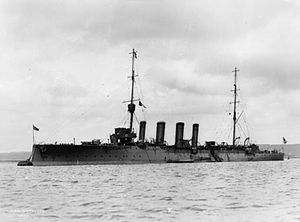HMS Weymouth (1910)
 HMS Weymouth in 1912
| |
| History | |
|---|---|
| Name | Weymouth |
| Namesake | Weymouth, Dorset |
| Builder | Armstrong Whitworth |
| Yard number | 827 |
| Laid down | 19 January 1910 |
| Launched | 18 November 1910 |
| Commissioned | October 1911 |
| Fate | Sold for scrap, 2 October 1928 |
| General characteristics (as built) | |
| Class and type | Town-class light cruiser |
| Displacement | 5,275 long tons (5,360 t) |
| Length | |
| Beam | 47 ft 6 in (14.5 m) |
| Draught | 15 ft 6 in (4.72 m) (mean) |
| Installed power |
|
| Propulsion | 2 × shafts; 2 × Parsons steam turbines |
| Speed | 25 kn (46 km/h; 29 mph) |
| Range | 5,610 nautical miles (10,390 km; 6,460 mi) at 10 knots (19 km/h; 12 mph) |
| Complement | 475 |
| Armament |
|
| Armour |
|
HMS Weymouth was a
Design and description
The Weymouth sub-class were slightly larger and improved versions of the preceding
The Weymouths exchanged the ten 4-inch (102 mm) guns of the Bristol sub-class for six additional
The Weymouth-class ships were considered protected cruisers, with an armoured deck providing protection for the ships' vitals. The armoured deck was 2 inches (51 mm) thick over the magazines and machinery, 1 inch (25 mm) over the steering gear and 0.75 inches (19 mm) elsewhere. The conning tower was protected by 4 inches of armour, with the gun shields having 3-inch (76 mm) armour, as did the ammunition hoists.[5] As the protective deck was at waterline, the ships were given a large metacentric height so that they would remain stable in the event of flooding above the armoured deck. This, however, resulted in the ships rolling badly making them poor gun platforms.[6] One problem with the armour of the Weymouths which was shared with the other Town-class ships was the sizable gap between the bottom of the gun shields and the deck, which allowed shell splinters to pass through the gap, which resulted in leg injuries to the ships' gun crews.[7]
Construction and career
The ship was laid down on 19 January 1910 by

Weymouth was transferred to the Adriatic in December 1915. In 1916 she returned to home waters and was assigned to the 6th Light Cruiser Squadron of the Grand Fleet. In 1917 she was reassigned to the Mediterranean as part of the 8th Cruiser Squadron operating out of Brindisi. She was damaged by a torpedo from the Austro-Hungarian submarine SM U-31 on 2 October 1918. She was repaired and survived the war.[1] She was sold on 2 October 1928 to Hughes Bolckow, of Blyth.[8]
Notes
Bibliography
- Brown, David K. (2010). The Grand Fleet: Warship Design and Development 1906–1922. Barnsley, UK: Seaforth Publishing. ISBN 978-1-84832-085-7.
- ISBN 978-1-86176-281-8.
- ISBN 0-89839-256-X.
- ISBN 1-870423-74-7.
- Friedman, Norman (2010). British Cruisers: Two World Wars and After. Barnsley, South Yorkshire, UK: Seaforth. ISBN 978-1-59114-078-8.
- Friedman, Norman (2011). Naval Weapons of World War One. Barnsley, South Yorkshire, UK: Seaforth. ISBN 978-1-84832-100-7.
- Gardiner, Robert & Gray, Randal, eds. (1985). Conway's All the World's Fighting Ships 1906–1921. Annapolis, Maryland: Naval Institute Press. ISBN 0-85177-245-5.
- Lyon, David (1977). "The First Town Class 1908–31: Part 1". ISBN 0-85177-132-7.
- Lyon, David (1977). "The First Town Class 1908–31: Part 2". Warship. 1 (2). London: Conway Maritime Press: 54–61. ISBN 0-85177-132-7.
- Lyon, David (1977). "The First Town Class 1908–31: Part 3". Warship. 1 (3). London: Conway Maritime Press: 46–51. ISBN 0-85177-132-7.
- Newbolt, Henry (1996). Naval Operations. History of the Great War Based on Official Documents. Vol. V (reprint of the 1931 ed.). Nashville, Tennessee: Battery Press. ISBN 0-89839-255-1.
External links
 Media related to HMS Weymouth (1910) at Wikimedia Commons
Media related to HMS Weymouth (1910) at Wikimedia Commons- Ships of the Weymouth group
